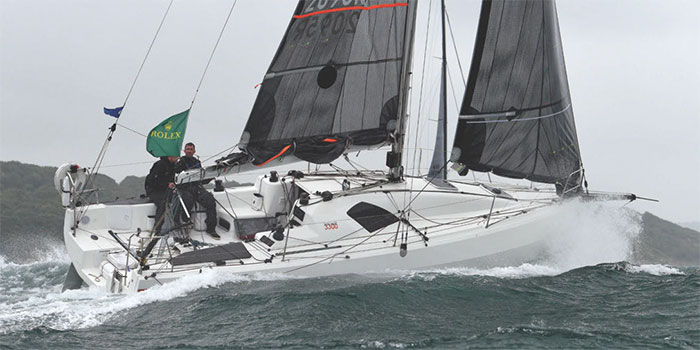

Kate Cope on how to prepare a doublehanded boat (part one of two)
The 2023 RORC Rolex Fastnet race had its toughest weather conditions in recent years. Three frontal systems crossed its track, the first of which was a SW gale force eight, gusting nine from the Needles to Portland Bill. This was well forecast so the boats had time to prepare, but what is the best way to spend your time ahead of the race? I spoke to a range of different boats in the UK Doublehanded series fleet to find out what worked well.
When there are only two co-skippers aboard preparations must be meticulous to ensure you are not overwhelmed by the conditions. Most successful doublehanded teams recognised the potentially boat-breaking and people-bruising conditions and refined their race strategy to keeping things in one piece and then thought of the “race” as beginning after the first frontal system moved on.
Normally a boat would have a median rig tension setup for the expected overall race conditions but this time most went with a setup for the windiest conditions. Cora put on an additional backstay strop on to protect the rig if any of the blocks were to break and tied a lot of heavy stuff to the bottom of the rig to keep weight central and low: anchors, spare fuel and water canisters.
Many took the sheets and guys off before the start to reduce drag and avoid ropes washing overboard and trailing behind. At least two boats installed extra padeyes at the helm to enable a short tether to be clipped on whilst steering, or alternatively, short tether anchor points on the side deck near the helm along with a decent loop to hold onto. Both setups reduced the risk of being thrown across the cockpit in the waves. A couple of boats installed extra non-slip deck grip as, during the St Malo race, one skipper had slipped down the stairs and deadlegged himself on the chart table.
There were some great ideas on how to keep the water out of the boat: taping up the forehatch and having an easy fit flexible screen over the main hatch made an immense difference to keeping the boat drier and warm. One team without a screen said they could have avoided getting wet clothes, destroying a phone and a mouse and wished they had installed one.
Dedicating dry and wet space helps, for example having a “dry” aft cabin and a “wet” space for sleeping in kit when on call. Learnings also included keeping the kit in dry bags only – on one boat all their clothes in fabric wardrobes ended up on the floor in a puddle of water.
Finally, before leaving the marina it was good to run through a reminder on safety procedures and location of the emergency equipment. For the 30-45kts upwind section on the first day, the most wellbalanced sail setup was a dedicated J4 heavy weather jib and three reefs in the main. For many with previous experience these sails were rigged and reefed on the dock or in the shelter of the Medina River. Most teams accepted the need to be a little conservative in the Solent, consistent with the strategy to stay in one piece during the first gale.
With headsails in headfoils, the addition of soft loops in the luff cringles going around the headstay gives a backup in case the luff popped out from the foil. Some boats without a dedicated J4 used a reefed J3 but it was not as successful. Many of the doublehanded boats do use reefing headsails with zipper systems available to manage the excess sailcloth, however they then needed to swap down to a storm jib as the wind strength increased overnight. Jago reported having issues with tangled sheets in the process of setting the storm jib and lost valuable time as they had to bear away to fix it. Asgard lost grip of their furled storm jib and its head smashed a hole in the mainsail causing them to retire. One boat wished they could reduce the sail area from a reefed J3 because boats with storm sails up were going faster. However, they had never used the storm sail in anger and didn't fancy going on the foredeck which was like a “bucking bronco” in the massive waves. They were surviving and thought it best just to hold on.
For the mainsail it was generally concluded having three sets of reefing points was essential in the conditions, others without this option had the much more difficult task of setting rarely used storm trysails or hanging on. Also, the ability to put in at least one reef from the cockpit solo would have helped later on in the race.
Thanks to the co-skippers of Fastrak, Jangada, Disko Trouper, Cora, Jago, Surf, Solenn for Pure Ocean, Orbit and Mzungu! for sharing their insights.
Click here for more information on the Double Handed Offshore Series »
Click here for more information on Sea Ventures »
We invite you to read on and find out for yourself why Seahorse is the most highly-rated source in the world for anyone who is serious about their racing.
To read on simply SIGN up NOW
Take advantage of our very best subscription offer or order a single copy of this issue of Seahorse.
Online at:
www.seahorse.co.uk/shop and use the code TECH20
Or for iPad simply download the Seahorse App at the iTunes store


